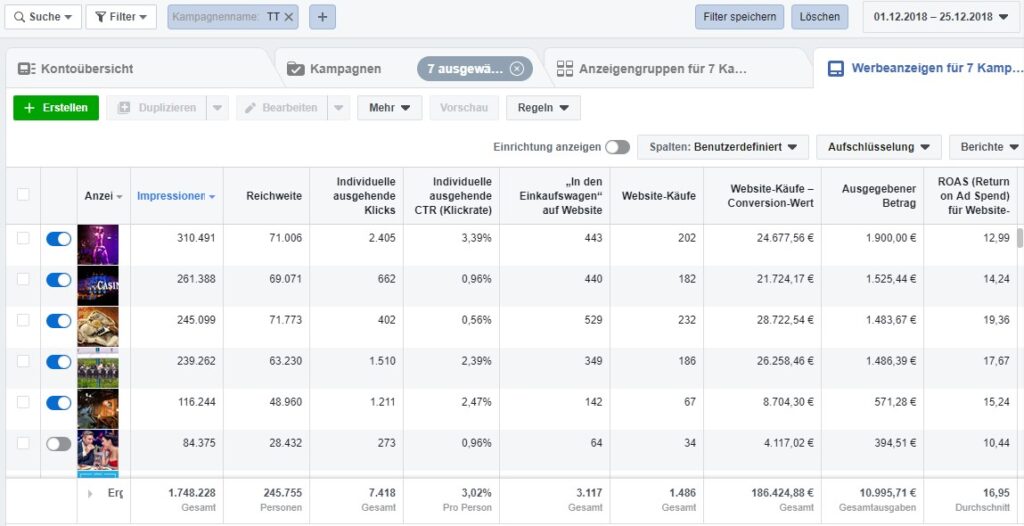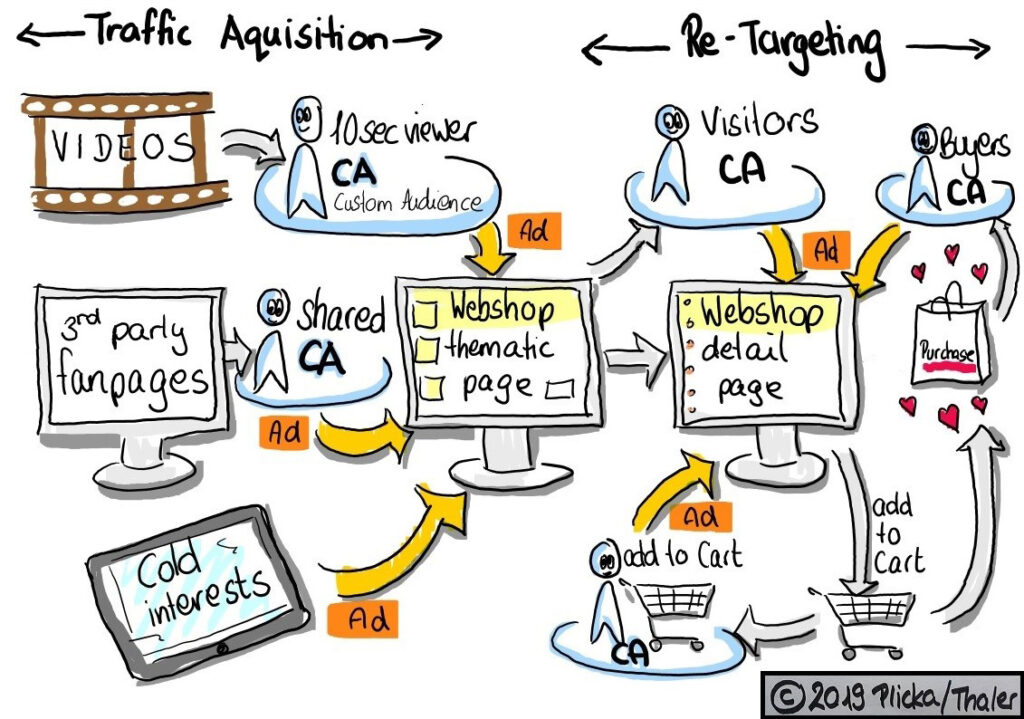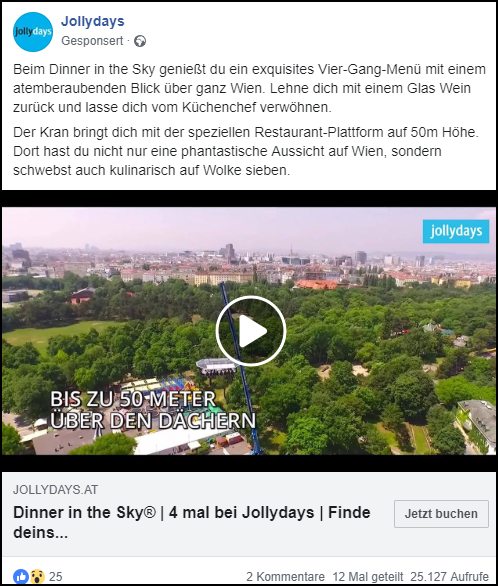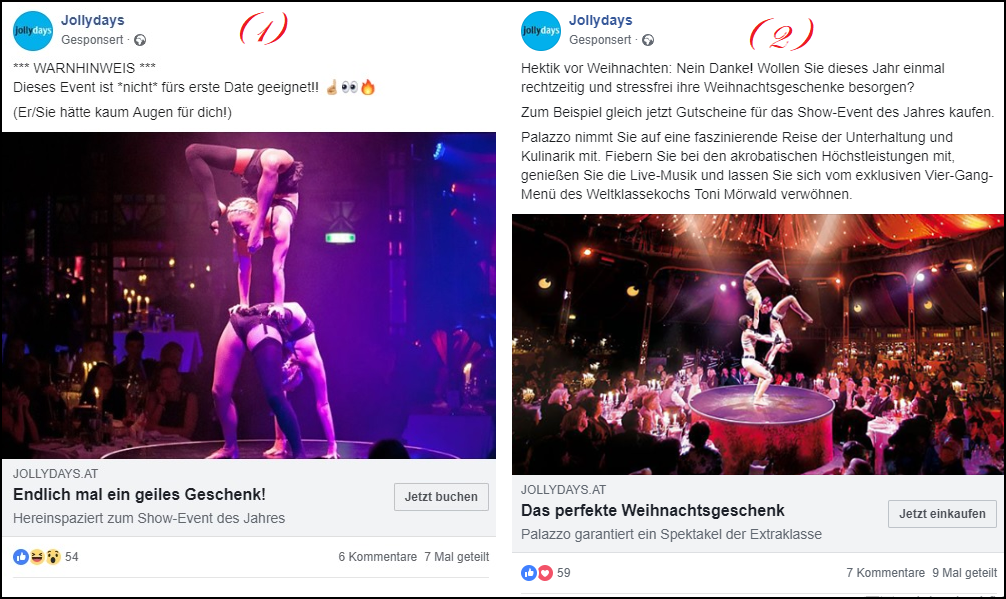
With the use of just under 11,000€, a turnover of over 186,000€ was generated – this corresponds to a return-on-ad-spend ( ROAS )of over 16.9. With the so-called squeeze out carpetbomb, we first bomb the broad mass, build owned audiences, optimize the traffic on AddToCart and finally force these users with maximum frequency politely but firmly to purchase.
———————————————
Author: Thomas Thaler, January 23, 2019
Every few weeks I read from (alleged) experts “You can’t sell anything on Facebook!”.
At the same time, Facebook’s official success stories usually lack concrete figures on the revenues and expenses of a campaign. So it’s not so easy for many advertisers to find their own valid line of argument without sending too much educational money to sunny California.
I myself have not yet come across any tactic that works for every requirement in performance marketing – even if this is promised in so many paid webinars. So today I’m going to present you one of many strategies in detail, which is especially promising for smaller (up to 500€ per day) budgets, already existing traffic (six-figure hits per month) and a good conversion rate (at least 2%) in the webshop.
To make the reading a little more exciting, I’ll show the whole thing using a concrete Facebook campaign that we managed during the Christmas shopping season from December 1 to 25, 2018:
With the use of just under 11,000€, this generated sales of over 186,000€ – which equates to a return-on-ad-spend ( ROAS) of over 16.9.
Now comes a sentence that reliably leads to the goal in every bullshit bingo: In the so-called squeeze out carpet bombing, we first build up owned audiences, optimize the traffic on AddToCart and finally force these users with maximum frequency politely but firmly to purchase. So to speak: “Buy! Buy! Buy!”
Always choose the right key performance indicators (KPIs)
Even before the campaign starts, we have to choose from the vast number of metrics that Facebook makes available those that we can use to manage the campaign operationally and ultimately assess its success.
We elegantly ignore the ROI, but focus primarily on the Return-On-Ad-Spend (aka ROAS). This qualitative indicator ultimately gives us information about the profitability or impact of our campaign: How much revenue do we generate with the advertising budget used (all excluding sales tax, of course)? Overhead costs and variable costs such as material usage are naturally not taken into account in this indicator – so we should be able to achieve a ROAS of at least 3 from the hip in order to be able to sleep reasonably soundly. In other words, 1,000€ of advertising money should generate at least 3,000€ of sales.
Caution: Never compare apples with oranges! In many of Facebook’s best-cases, concrete Euros are used on the expenditure side and only extrapolated purchase probabilities based on non-binding opinion polls are used on the revenue side. Such a procedure may be sufficient for international corporations, but for us bean counters it is a mortal sin.
We therefore choose a short-term attribution window of 1-day-view / 1-day-click, so in this case we only attribute actual purchases within 24h of the ad.
Facebook distinguishes between 6 different types of clicks and click-through rates – each has its advantages and disadvantages. Often used is the quantitative metric outbound clicks – this is the gross total of all clicks on external landing pages.
Nevertheless, in our ongoing analysis, we opt for the individual outbound clicks, which is the net total (i.e. how many people) of all clicks on external landing pages – in my view, the most suitable KPI.
The qualitative KPI individual outbound click rate (= CTR) then tells us how “appropriate” an ad was to the selected target group. Since this KPI is measured against reach and not against impressions, a high frequency does not distort the result. If this CTR is significantly below 1% for link ads, this is often an indication of target groups that are too broad.
In the following screenshot, 7,418 people clicked a total of 8,309 times on an external link and 7,508 (= 15,817 – 8,309) elsewhere.

In order to be able to correctly interpret the behavior of the users in our web store, we also need the two pixel events AddToCart and Purchase. In the Purchase event, we transfer the generated sales excluding sales tax and can thus have Facebook calculate the ROAS achieved per ad at any time.

We arrange all the KPIs in the AdManager using “Customize columns”, save the whole thing for later use and are now ready to start the campaign.
Phase 1: Which targeting do we use?
Jollydays is the leading provider of experience gifts in the Austrian market. Already on the market since 2003, the internal marketing team there now has very extensive historical data on which gifts are bought at which time of the year. So out of the more than 6,000 experiences on offer, we’ll only pick a few from the top 20 sellers (from skydiving to culinary) – and we’ll promote those manually.

Unfortunately, someone who wants to give away a casino voucher for Christmas is not necessarily interested in doing so themselves – so the classic targeting of Facebook will probably not really help us.
We therefore use the tried-and-tested technique of carpet-bombing in advance: First, we place a few thematic video ads with the broadest possible targeting, optimized for video views, with a low budget. From these viewers we create several Custom Audiences, which we later use as target groups.
The longer the user has watched such a video, the better the click-through rates of the later sales campaigns usually become. I usually use the 10-second views – as a feasible price per person in the future target group, you can calculate 2c to 3c. Users who have seen 25% of the entire video after all also work very fine, but are more expensive.
The text in the ad as well as the CTA doesn’t matter much. The main thing is that the video used captivates the user for at least 10 seconds or longer.

Shared custom audiences from other fanpages with an affinity to the topic have also proven very effective, preferably the interactions of the last 7 days.
Phase 2: Drive traffic to the website
Now we place classic link ads on the previously generated target groups, which refer to so-called topic pages. These are not necessarily sales-triggered, but they collect supra-regional experiences and thus offer something across the whole of Austria. These ads are optimized for conversions (AddToCart).
Of course, sales are already triggered here – but the purpose of the exercise is primarily to increase the number of qualified visitors to the webshop: we build rolling Custom Audiences from website traffic, which we utilize immediately in phase 3:
- All visitors of the last 90 days
- All visitors of the last 30 days
- Visitors who spent at least 1min on the website
- Visitors who have added something to the shopping cart
- Visitors who have bought something
In this phase, AdManager rules have proven their worth, which automatically notify us as soon as an ad exceeds the cost per AddToCart of 6€. Around 8€ per event is our absolute pain threshold here, the frequency should not be much more than 5, we ignore the cost per purchase achieved in the process for now.
Phase 3: Start the citrus juicer
Now come normal link ads as well as carousel ads on the target groups of the previous phase, which refer directly to the individual product pages of our top seller products. This time optimized for conversions (purchase).
In this phase, the frequency is completely irrelevant, we only look at CTR and earning power. Ideally here would be the absolute key figure of the contribution margin (= conversion revenue – amount spent). Unfortunately, Facebook currently does not (yet) offer the possibility to store individual formulas in the AdManager, we use the ROAS instead.
Attention: The CPO (= cost per purchase) is very often described as a decisive key figure in the specialist literature. However, it actually plays a more than subordinate role in revenue-oriented performance marketing. As long as the ratio between revenues and expenses is right, the cost per purchase is irrelevant.
Forget the fear of overlapping target groups that has been drilled into us: After all, we want to squeeze out maximum revenue in a very limited amount of time, so we run up to seven ad groups at the same time with the same target groups. The CPM will be higher as a result, but we can safely ignore that as well, as long as the results are right. Ads with a CTR above 2% will be played by Facebook even if there are competing ad groups.
Sometimes 40 brains simply have better and more ideas than 2. We therefore get the creative support of the students of the Private University Schloss Seeburg as well as thehttps://weiterbildung.fhstp.ac.at/lehrgaenge/digital-marketing-msc University of Applied Sciences St. Pölten for the creation of the ads.
A total of 86 different ads for 14 different experiences were tested. Normally, each mutation should get at least 100 clicks – however, in case of subterranean bad results, we turn them off earlier.

The results for CTR and ROAS are significantly different in this example despite identical target groups and target page:

As soon as the postal delivery of the voucher is no longer feasible before Christmas, we will switch to “Delivery as PDF by eMail” in the webshop by default. This phase runs until Christmas Eve at 16:00, after which we ourselves all celebrate with the family.
Waiting for the remaining attribution window, the evening of December 25 is the official end of the project. 3,5 weeks of work are over.
